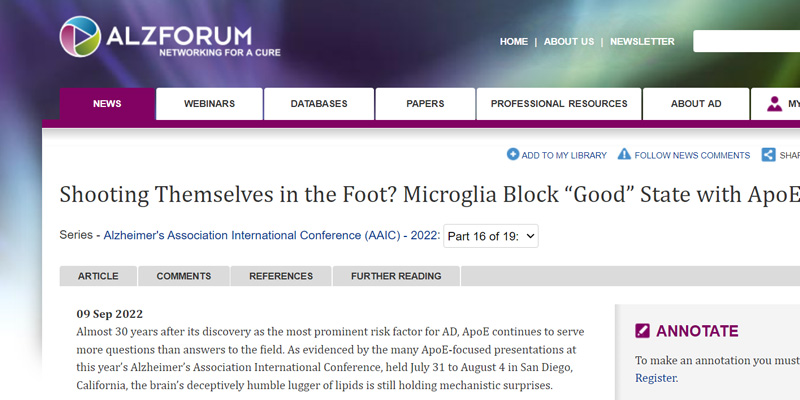In Amyloid and Tangle Models, APOE4 Paralyzes Microglia
Though APOE4 is the strongest genetic risk factor for sporadic Alzheimer’s disease, scientists have struggled for decades to figure out how it affects the cells of the brain. For microglia, at least, there may be some clarity. In the September 25 Nature Immunology, researchers led by Oleg Butovsky of Brigham and Women’s Hospital in Boston reported that, in mice, APOE4 causes microglia to ramp up the expression of homeostatic genes. This prevents the cells from clearing amyloid plaques and neurofibrillary tangles. Deleting APOE4, or PU.1, a master driver of microglial homeostasis, enabled the microglia to clear plaques and they recruited astrocytes to help.
Regulus Therapeutics collaboration
In June 2023, the Company announced that they had advanced to evaluation of compounds of interest in in vivo models in their collaboration with the laboratories of Oleg Butovsky, Ph.D., and Howard L. Weiner, M.D., at Brigham and Women's Hospital and the Foundation for Neurologic Diseases (Boston, MA). The compounds being evaluated are oligonucleotides designed to inhibit miR-155 for the treatment of Amyotrophic Lateral Sclerosis (ALS, or Lou Gehrig's disease).
Ridding Microglia of a MicroRNA Compacts Amyloid, Protects Synapses
Relinquishing microglia of a pesky 22-nucleotide microRNA freed the cells to respond more vigorously to amyloidosis, and to protect nearby neurons. That was the upshot of a study published in Nature Neuroscience on June 8, which was spurred by previous findings implicating this particular microRNA—miR155—in microglial function. When the scientists, led by Oleg Butovsky of Brigham and Women’s Hospital in Boston and Tsuneya Ikezu of the Mayo Clinic in Jacksonville, Florida, conditionally deleted miR-155 from microglia in APP/PS1 mice, the cells heightened their responses to IFN-γ. This bolstered phagocytosis, boosted containment of Aβ plaques, and ultimately protected synapses and spared memory loss. Notably, these benefits depended upon the interferon, a cytokine produced primarily by T cells. The findings underscore the complexity—and rich opportunities for therapeutic targets—embedded within the multi-pronged inflammatory response to amyloidosis.
New York times Article
Bruce Rosenblum first noticed his symptoms while gliding over rolling snow-covered hills. After a day of cross-country skiing, his balance seemed to shift, leaving him struggling to stay upright.
Shooting Themselves in the Foot? Microglia Block “Good” State with ApoE4
Almost 30 years after its discovery as the most prominent risk factor for AD, ApoE continues to serve more questions than answers to the field. As evidenced by the many ApoE-focused presentations at this year’s Alzheimer’s Association International Conference, held July 31 to August 4 in San Diego, California, the brain’s deceptively humble lugger of lipids is still holding mechanistic surprises...
AlzForum: ApoE and Trem2 Flip a Microglial Switch in Neurodegenerative Disease
A flurry of recent studies implicating microglia as key players in neurodegenerative diseases, particularly Alzheimer’s, has cued many labs to try to figure out how these cells function in health, and how they change in disease. Adding a piece to the puzzle, scientists led by Oleg Butovsky of Brigham and Women’s Hospital in Boston report in the September 19 issue of Immunity that two genes with variants known to alter Alzheimer’s risk—APOE and TREM2—orchestrate the cells’ passage from a homeostatic state to a disease-associated state, at least in mice. “This is a fascinating paper. It provides substantial evidence for an APOE-TREM2 pathway in mouse microglia that senses apoptotic neurons and induces a ‘neurodegenerative’ phenotypic switch,” wrote Christopher Glass, University of California, San Diego, in an email to Alzforum.
ALZ FORUM – On The Docket at AD/PD: The Many Crimes of ApoE4
Despite years of study, ApoE still has secrets to give up. At the 14th International Conference on Alzheimer’s and Parkinson’s Diseases, held March 27–31 in Lisbon, Portugal, researchers indicted ApoE4 on several fronts. They charged it with holding back the microglial response to amyloidosis. They said it bungled disposal of damaged mitochondria, perhaps perturbing cellular energy metabolism. They implicated it in axonal remodeling, and said this may explain why the highly arborized neurons of the entorhinal cortex are particularly vulnerable to Alzheimer’s. Finally, as peripheral ApoE is beginning to attract more attention, scientists are accounting for the different pools of this lipoprotein that course through the human body. Others elaborated on how ApoE4 damages blood vessels in the brain and correlates with neuroinflammation. Quite the rap sheet.
IMMUNITY: A Tale of Two Genes: Microglial Apoe and Trem2
Microglial cell function is implicated in the etiology of Alzheimer’s disease by human genetics. In this issue of Immunity, Krasemann et al. (2017) describe a gene expression signature associated with an APOE- and TREM2-dependent response of microglia to brain tissue damage that accumulates in aging and disease, defining an axis that might be amenable to therapeutic targeting.
NEUROLOGY TODAY: New Data Confirm the Role of Inflammatory Markers in ALS
A decade ago, scientists and doctors in working on amyotrophic lateral sclerosis (ALS) were beginning to suspect that inflammation was critical to the disease process. It wasn't a popular idea. But a growing body of evidence is mounting in support of this theory and is leading to the identification of possible immune system biomarkers and even novel treatments. Now, a team of Harvard scientists has outlined a clearer picture of the role that innate immunity plays in ALS. The finding, published in the Sept. 4 Journal of Clinical Investigation, suggests a specific microRNA gene signature rich with immune system regulators, and a recruitment of inflammatory monocytes that play a critical role in disease progression. Oleg Butovsky, PhD, Howard L. Weiner, MD, and their colleagues have spent several years unraveling the immune systems role in ALS, first in animals and then looking for similar pathways in patients.







